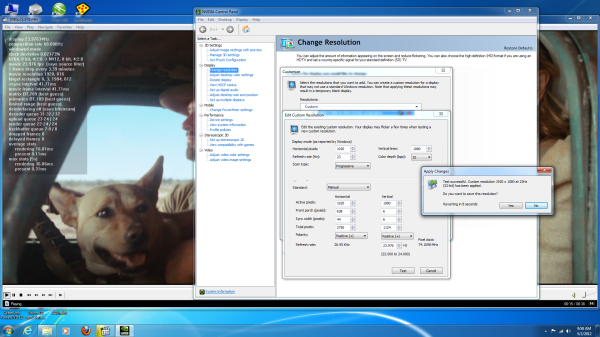ASRock's High-End Vision 3D 252B HTPC Review
by Ganesh T S on May 7, 2012 6:15 AM EST- Posted in
- Home Theater
- Sandy Bridge
- HTPC
- GT 540M
- NVIDIA
One of the issues with the ASRock CoreHT 252B was the fact that the integrated Intel HD Graphics 3000 was unable to refresh the display at 23.976 Hz even when configured manually. AMD GPUs have had a history of being close to the desired refresh rates out of the box, while NVIDIA GPUs end up needing some tweaking. This is further compounded by the fact that different setups behave differently even with the same card. How does the GT 540M in the Vision 3D 252B fare?
As we have recounted in earlier HTPC reviews, a GPU should ideally be capable of the following refresh rates at the minimum:
- 23.976 Hz
- 24 Hz
- 25 Hz
- 29.97 Hz
- 30 Hz
- 50 Hz
- 59.94 Hz
- 60 Hz
Some users demand integral multiples of 23.976 / 24 Hz because they result in a smoother desktop experience, while also making sure that the source and display refresh rates are still matched without repeated or dropped frames. The gallery below shows the refresh rate handling for 24, 25 (x2 = 50 Hz), 29.97 (x2 = 59.94 Hz), 30 (x2 = 60 Hz), 50, 59.94 and 60 Hz settings.
The native 23 Hz setting, unfortunately, resulted in a 23.971 Hz refresh rate.
However, with some custom timing setup, we were able to achieve 23.97634 Hz.
The custom timing feature is usable, but not without its quirks. Adding a custom resolution is straightforward. Setting the vertical parameters to values similar to the ones in the screenshot above achieves desired results, but the 23 Hz resolution gets saved as 24 Hz. The pictures in the gallery below bring out the issue. The first picture shows that the 23 Hz setting gets saved as 24 Hz in the NVIDIA control panel. The second picture shows that the 24 Hz setting is no longer available in the set of native refresh rates. The third picture shows that all the available EDID resolutions are displayed in the monitor properties. The fourth screenshot shows that setting the 23 Hz option in the monitor properties puts the control panel in 24 Hz custom mode (with the screen refreshing at 23.97637 Hz). The fifth screenshot shows the effect of setting the 24 Hz option in the monitor properties. Note that the control panel still shows the custom 24 Hz setting. In the sixth screenshot, we selected the 23 Hz setting of the NVIDIA control panel (under native resolution - the one that we actually intended to replace in the first place) only to get the display refreshing at 23.971 Hz. The final picture shows the NVIDIA control panel set to custom 24 Hz resulting in a display refresh rate closer to the intended 23.976 Hz.
We hope NVIDIA fixes this annoying issue in one of the upcoming driver releases.























60 Comments
View All Comments
ganeshts - Monday, May 7, 2012 - link
I agree that the necessary information is spread out over multiple sites / reviews. We will work towards maintaining a database for easy access to all the information from a central point.ggathagan - Monday, May 7, 2012 - link
There's already an extensive guide:http://imouto.my/watching-h264-videos-using-dxva/
http://imouto.my/watching-h264-videos-using-dxva-c...
An alternative to MPC-HC is a Korean product called Pot player:
http://imouto.my/configuring-potplayer-for-gpu-acc...
I've used both players with a GTS 450, an AMD 6950 and an AMD 5670 without issue after following the guides.
aliasfox - Monday, May 7, 2012 - link
First off, I skimmed the article, so forgive me if this is really obvious. Second, I have an admitted Mac bias, so that's where this is coming from. So here goes:With the exception of the Blu-Ray drive and USB3, is there really much that makes this worth so much more than a Mac Mini? I'm thinking the $799, i7, Radeon 6670m equipped model.
$100 to load Windows onto it (if that's your flavor), and $200 should get you a blu-ray player - that leaves that set up $100 cheaper than the ASRock...
The Mac mini does dual display, has HDMI out, and has an optical audio output as well. Admittedly, the SD Card reader on the back is less easy to get to than a reader on the front, and the base HDD is smaller (500 GB).
Different strokes for different folks?
lenkiatleong - Tuesday, May 8, 2012 - link
But Mac mini does not bitstream HD audio to AV as far as i know. And this is the most critical point in my opinion for HTPC.philipma1957 - Monday, May 7, 2012 - link
1.2k for 1.2 k I can have a 2500k cpu a crucial 256gb ssd a 2tb hdd a blu ray from asus 8gb ram a mobo from asus the catch is I need a 14 by 14 by 7 inch case.Any real hi end ht has amps, larger speakers ,large tv. Some subs not one sub.
A gear rack and hiding a case the size of 14 by 14 by 7 on a gear rack is easy.
This is for a design freak with tiny little bose speakers and a wall mount led flat screen.
while that ht is costly ie hi end it makes poor quality sound.
ganeshts - Monday, May 7, 2012 - link
This is a HTPC for the high end home theater. Nothing prevents you from routing the HDMI output from the Vision 3D 252B to an amp / pre-amps and use that to drive the large speakers.aliasfox - Monday, May 7, 2012 - link
Or potentially it's for people who are limited on storage rack space. My five level rack currently houses my blu-ray player, receiver, and dedicated stereo amp, as well as my cable modem and router which live on one shelf.If I were to replace my receiver (currently acting as my pre/pro) with a dedicated pre/pro and another amp to do surround duties, I wouldn't have another entire shelf for a big box htpc - I'd only have the space next to the modem and router to share.
zerorift - Monday, May 7, 2012 - link
Maybe I'm just not seeing this in the review, but what software did you use to record the graphs of power usage?ganeshts - Monday, May 7, 2012 - link
The graphs are from HWInfo. The software is capable of much more than just simple graphing. Here is another screenshot (and the link to the software):http://www.hwinfo.com/images/HWiNFO32_1.png
www.hwinfo.com
nsparadox - Monday, May 7, 2012 - link
I used to build HTPCs back in the day to record shows as a glorified DVR. There's no bundled tuner. What's the point of HTPCs nowadays, assuming you're not using them as a DVR?I can do pretty much all of these things this machine can do with a Blu-Ray player, Google TV, integrated TV software, a Roku box, or just an HDMI out to an existing tablet or laptop PC. And the prices for these approaches ranges from free to $200 depending on what equipment you already have?
Even for massive movie hoarders who want to stream their collection, you can do that with most of these devices.